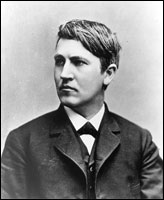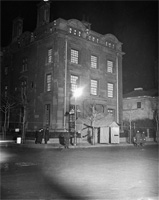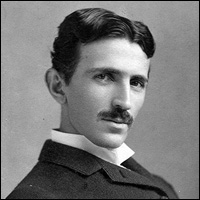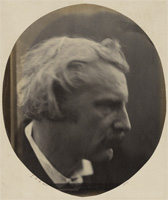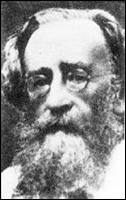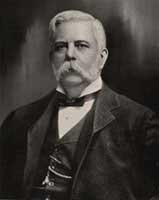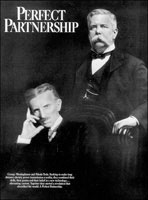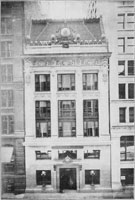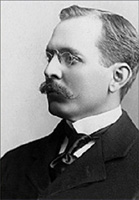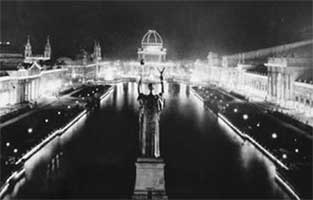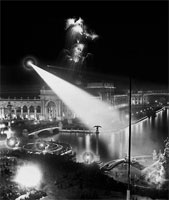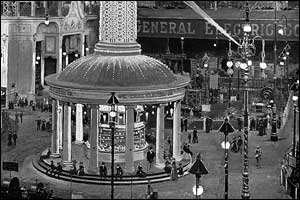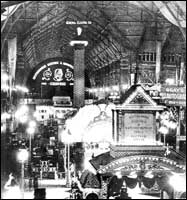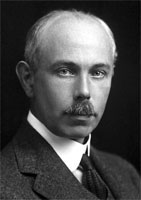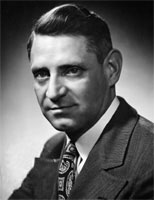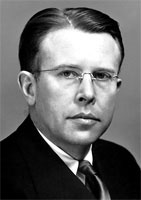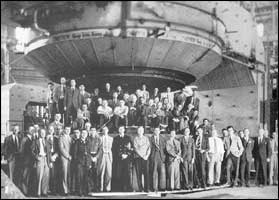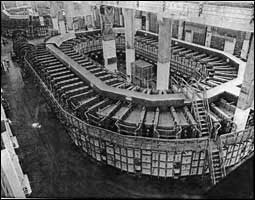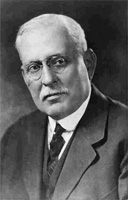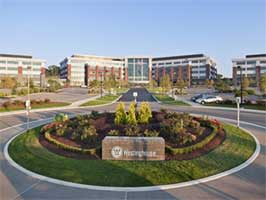SAMUEL INSULL WORKED WITH THOMAS EDISON TO STEAL NIKOLA TESLA'S 3-PHASE ALTERNATIING CURRENT SYSTEM. |
For lighting and power, every country in the world uses the polyphase alternating current system invented by Nikola Tesla. Even Buddhist/Communist China uses his AC to make weapons of mass production.
|
|
|
On February 28, 1881, 21-year-old British Secret Service agent Samuel Insull arrived from London and started working for fellow agent Thomas Edison in New York.
|
At that time, Edison was trying to illuminate Manhattan with direct current. He built a huge coal powered direct current generating station at Pearl Street in Lower Manhattan. Unfortunately, the huge generating station could only light up 400 lamps within the immediate vicinity.
J.P. Morgan was his financier, and Edison succeeded in lighting up Morgan's mansion by the use of a huge dynamo in the basement. It was so noisy that Morgan later had it moved to the garage.
|
The 21-year-old Insull lost no time in taking over the Edison Company:
Insull began his crusade to police Edison's troubled books with Charles Batchelor, one of Edison's many capable vice presidents. Batchelor was instrumental in running Edison's research and growing manufacturing operations, and one of the pioneers from the Menlo Park days. It is not clear exactly how he regarded Insull, who had neither served in Menlo Park nor was with Edison in the 1870s, yet it was now Insull, in a martinetlike tone, who was issuing marching orders. In a letter to Batchelor on September 28, 1882, Insull outlined his strategy, combing through each of Edison's main units: "I think it well to begin with the most expensive subject first. The Lamp Factory continues to absorb money right along. They are turning out at the present time from about 800 to 1,000 [light bulbs] a day and still lose on everything that they sell." (Wasik, The Merchant of Power, p. 23)
The Edison Company was indeed stuck in neutral, until the day that the greatest genius that ever lived walked into Edison's office, with a letter of introduction from Charles Batchelor in Paris.
Nikola Tesla arrived in Edison's office on June 7, 1884
In April 1882, Tesla moved to Paris, where he began working for the Continental Edison Company, designing and making improvements to DC electrical equipment. His boss there was a British textile industry employee named Charles Batchelor.
Batchelor advised Tesla to go to New York and he gave him a glowing letter of recommendation for his fellow agent Thomas Edison.
|
|
Edison gave Tesla a job fixing his unreliable DC dynamos. The SS Oregon was stuck in the docks over on the East River because Edison's on-board lighting system had failed to work. Edison promised Tesla $50,000 if he could fix it. Tesla fixed it in record time and then asked for his money. Edison replied that he was only joking so Tesla quit in disgust.
Edison swifty sent Samuel Insull to London with Tesla's AC motor plans!!
While Edison was deriding Tesla and his AC motor, Edison ordered Samuel Insull to leave for London immedially. Insull know all the important people in British government–especially Sir Coots Lindsay.
|
|
|
Obviously, Insull knew that there was nothing experimental about Tesla's system or he wouldn't have installed 2 Tesla alternators in the very center of London.
George Westinghouse brought Tesla's polyphase system to the world!!
In spite of all the advantages of the AC system, Edison refused to acknowledge its superiority over his system, so inventor George Westinghouse of Pittsburgh came to his rescue. As a matter of fact, Insull, Edison and his boss Morgan sulked like spoilt children, and started what became known in U.S. history as the War of the Currents, or the battles between AC and DC.
|
By 1886, the Westinghouse Company was one of the biggest and most successful in the entire world.
Westinghouse was a Protestant Christian gentleman and totally unlike the robber barons of that era....His motto was the golden rule, and his employees shared in the success of his company. He believed in doing his good works in secret, and many charities throughout the country were helped by his largess.
He offered to buy all the AC patents from Tesla for the staggering sum of 1 million dollars cash and royalties of $1.00 per horsepower of electricity produced.
Unlike Edison, George Westinghouse was a man of his word, and offered Tesla a staggering sum for all his AC patents:
So favorably impressed was Westinghouse that he decided to act quickly. The story was related to the author by Tesla.
"I will give you one million dollars cash for your alternating current patents, plus royalty," Westinghouse blurted at the startled Tesla. This tall, suave gentleman, however, gave no outward sign that he had almost been bowled over by surprise.
"If you will make the royalty one dollar per horsepower, I will accept the offer," Tesla replied.
"A million cash, a dollar a horsepower royalty," Westinghouse repeated.
"That is acceptable," said Tesla.
"Sold," said Westinghouse. "You will receive a check and a contract in a few days."
Here was a case of two great men, each possessed with the power of seeing visions of the future on a gigantic panorama, and each with complete faith in the other, arranging a tremendous transaction with utter disregard of details. (O'Neill, Prodigal Genius, pp. 74-75).
The decision to give the world alternating current put George Westinghouse on a collision course with Insull, Edison, and Morgan.
In 1892, Insull moved to Chicago to sabotage alternating current!!
The big test to determine which system would prevail was the upcoming 1893 Columbian Exposition, or the first Chicago World's Fair.
It was meant to celebrate the 400th anniversary of Portuguese Christopher Columbus landing in the New World. However, 1892 was a Presidential election year so the celebration was held on the following year.
The city of Chicago had requested bids from General Electric and Westinghouse to light up the Columbian Exposition.
|
He was determined to totally exclude Tesla and Westinghouse from the upcoming Columbian Exposition.
Insull's money came from the Bank of England, and he was the John D. Rockefeller of the electrical industry. Like Rockefeller, he used the same ruthless "cutting to kill" tactics to drive all the small companies out of business.
The company created by Insull, Edison, and Morgan was called General Electric. Edison's name was totally excluded from the company because he couldn't even invent a mousetrap.
|
Edison had a patent on light bulbs so he refused to let Westinghouse use his bulbs. Tesla just invented a new bi-pin bulb that circumvented the Edison patent.
|
The millions who visited the fair returned home wondering why their dark nights should not be illuminated by the wonderful new discovery of electricity. Insull was also at the Fair, observing everything very closely, and he saw the handwriting on the wall for Edison's direct current.
Insull was anxious to begin metering alternating current!!
As head of the Chicago Edison Company, Insull knew that the future belonged to AC; he could not stop progress, and continue to keep the world in the dark. His fellow spies told him of a device that was invented by an Englishman to measure electric current usage. For that reason he returned home in 1894 to observe the device in operation.
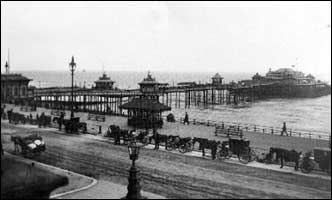 Brighton, England, circa 1894. It was the first city in the world to use metered electricity. |
|
Here is a quote about Insull's visit to Brighton, England, and his meeting with Arthur Wright (Wrong):
Toward the end of 1894, Insull went back to England for Christmas vacation and spent a few days by the sea at Brighton, on the southern coast. On his first evening in Brighton he saw an unfamiliar sight: Every shop, even the smallest, seemed to be burning electric lights, and no one appeared to be squeamish about the abundant use of electricity. As curious as he was amazed, Insull looked up the city official who managed the plant–like many small central stations in England, Brighton's was owned by the municipality–and found an unassuming young man named Arthur Wright. Wright attributed his success to a device that he had invented and which he called a demand meter. The idea was simple. The cost of producing electric light, he explained to Insull, is really two costs, fixed costs and operating costs, each of which varies from customer to customer. Accordingly, said Wright, it is no more sensible to have a uniform rate than it is to have a uniform flat charge. Suppose, he said, that you have a customer who owns a vacation cottage wired for twenty lamps, but he burns them only three or four weekends a year. Because you have to invest so much money in equipment to be ready to serve him any time he flicks his switches, it costs more than half as much to serve him those few weekends as it would to serve him day and night throughout the year. Now suppose, Wright continued, that you have another customer who has the same number of lamps but uses them for several hours every night. To charge these two customers the same rate would be absurd; you make more money out of the second customer at a penny a kilowatt-hour than you do out of the first at four times that rate. Wright measured every customer's use of electricity in two parts, each corresponding to a part of the cost:one part to see how much equipment the customer necessitated, and the other part to see how much he used the equipment. The charge for service was a combination of the two: a given rate for the first few hours of use of the maximum demand, somewhat less for the next few hours thereof, still less for the next few, and so on. (McDonald, Insull, pp. 67-68).
This was the beginning of electric bills for U.S. customers. The only contribution to the development of electricity that the British made was the demand meter!!
Insull used Tesla's AC to develop the atomic bomb!!
After "Kissin' Cousins" Charles Darwin's On the Origin of Species by Natural Selection, the most exciting book for the British Empire was published in 1875. It was entitled Physics of the Ether by Samuel Tolver Preston. Like Nikola Tesla, Preston believed in the existence of the ether.
To the military establishment in the British Empire, it held out the possibility of an atomic bomb to destroy Britannia's 3 main rivals: France, Russia, and the United States. This goal was even more critical following the disastrous defeat of the British/German Coalition in World War I.
As research on this super weapon progressed, it became apparent that splitting the atom would require enormous amounts of alternating current.
|
Ernest Lawrence arrived at the University of California in 1926:
As far back as his first year of graduate school, 1922, Lawrence had begun to think about how to generate high energies. His flamboyant, fatherly mentor encouraged him. William Francis Gray Swann, an Englishman who had found his way to Minnesota via the Department of Terrestrial Magnetism of the District of Columbia's private Carnegie Institution, took Lawrence along with him first to Chicago and then to Yale as he moved up the academic ladder himself. After Lawrence earned his Ph.D. and a promising reputation Swann convinced Yale to jump him over the traditional four years of instructorship to a starting position as assistant professor of physics. Swann's leaving Yale in 1926 was one reason Lawrence had decided to move West, that and Berkeley's offer of an associate professorship, a good laboratory, as many graduate-student assistants as he could handle and $3,300 a year, an offer Yale chose not to match. (Rhodes, The Making of the Atomic Bomb, p. 144).
His mentor Swann encouraged him to focus on electromagnetic isotope separation. In 1930, Lawrence invented a circular magnetic resonance accelerator. He called it a cyclotron because it accelerated protons in a circular trajectory.
|
After the British attack on Pearl Harbor, the Manhattan Project was created to help Hitler with his atomic bomb. Very conveniently, a massive amount of electricity was available in Tennessee, thanks to Roosevelt's Tennessee Valley Authority hydroelectric project.
Prior to that time, the government never became involved in private enterprise. Even the Morse telegraph did not receive any government funding.
|
Immediately after coming online in 1943, the top secret Oak Ridge calutron racetrack began electromagnetic separation of U-235. Some of the nuclear fuel was loaded on submarines and taken to Germany for shipment to the vast underground nuclear facility at Terezin. Only the Day of Judgment will reveal how close Hitler was to have an atomic bomb to change the outcome of World War II.
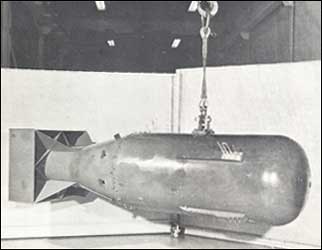 "Little Boy"–the second uranium bomb–was made possible by Oak Ridge uranium. |
|
The legacy of Insull is still with us today . . . as sinister as ever....The George Westinghouse Company is totally involved in constructing nuclear power stations, and is owned by a Japanese company, the Toshiba Group. Add to that the high electric bills that people around the world have to pay every month to the electric monopolies.
Nikola Tesla was never involved with any of the fake "Jews" who were working feverishly on Hitler's atomic bomb.
|
|
|
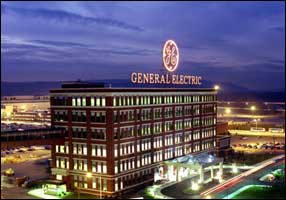 General Electric HQ in Fairfield, CT, is lit up by Tesla's AC. |
The British owned General Electric Company has annual revenues exceeding 150 billion dollars. It is a vital part of the nuclear weapons industry, and the major player in the military-industrial complex condemned by President Eisenhower.
Most of the revenues of General Electric comes from the inventions of Nikola Tesla: motors, turbines, radio, TV, x-rays, robotics, etc., etc. The HAARP system, which is used to modify the weather in the U.S., was invented by Tesla to make the desert blossom as the rose.
Vital links
References
Childress, David H. The Fantastic Inventions of Nikola Tesla. Adventures Unlimited Press, Selle, Illinois. 1993.
Cheney, Margaret. Tesla, Man out of Time. Prentice-Hall, Inc., Englewood Cliffs, NJ, 1981.
Garbedian, Gordon H. George Westinghouse: Fabulous Inventor. Dodd, Mead & Co., New York, 1943.
Herken, Gregg. Brotherhood of the Bomb. The Tangled Lives and Loyalties of Robert Oppenheimer, Ernest Lawrence and Edward Teller. Henry Holt & Company, New York, 2002.
Jones, Jill, Empires of Light. Edison, Tesla, Westinghouse and the Race to Electrify the World. Random House, New York, 2003.
McDonald, Forrest. Insull. The University of Chicago Press, Chicago, Illinois, 1962.
Insull. Samuel. The Memoirs of Samuel Insull. Transportation Trails, Polo, Illinois, 1992. (Originally published in 1934).
O' Neill, John J. Prodigal Genius. The Life of Nikola Tesla. Ives Washburn, New York, 1944.
Rhodes, Richard. The Making of the Atomic Bomb. Simon & Schuster, New York,1986.
Seifer, Marc J. Wizard. The Life and Times of Nikola Tesla. Biography of a Genius. Carol Publishing Group, Secacaus, NJ, 1996.
Wasik, John F. The Merchant of Power: Samuel Insull, Thomas Edison, and the Creation of the Modern Metropolis. Palgrave Macmillan, New York, 2006.
Copyright © 2015 by Patrick Scrivener
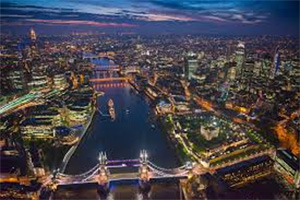
 Buckingham Palace is lit up by
Buckingham Palace is lit up by 
